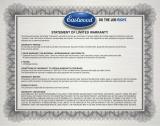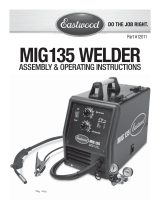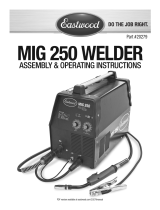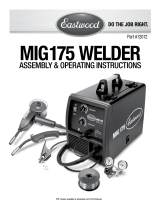
ARC200i WELDER
ASSEMBLY & OPERATING INSTRUCTIONS
Item #20484

2 Eastwood Technical Assistance: 800.544.5118 >> techelp@eastwood.com
STATEMENT OF LIMITED WARRANTY
The Eastwood Company (hereinafter “Eastwood”) warrants to the end user (purchaser) of all new welding and cutting equipment (collectively called the “products”) that it will
be free of defects in workmanship and material. This warranty is void if the equipment has been subjected to improper installation, improper care or abnormal operations.
WARRANTY PERIOD:
All warranty periods begin on the date of purchase from Eastwood. Warranty Periods are listed below, along with the products covered during those warranty periods:
3 Year Warranty on Material, Workmanship, and Defects:
• Eastwood ARC200i Welder
Items not covered under this warranty: Collets, Collet Bodies, electrodes, nozzles, and ground clamp and cable.
All other components are covered by the warranty and will be repaired or replaced at the discretion of Eastwood.
2 Years:
• All Welding Helmets.
CONDITIONS OF WARRANTY TO OBTAIN WARRANTY COVERAGE:
Purchaser must first contact Eastwood at 1-800-345-1178 for an RMA# before Eastwood will accept any welder returns.
Final determination of warranty on welding and cutting equipment will be made by Eastwood.
WARRANTY REPAIR:
If Eastwood confirms the existence of a defect covered under this warranty plan, Eastwood will determine whether repair or replacement is the most suitable option
to rectify the defect. At Eastwood’s request, the purchaser must return, to Eastwood, any products claimed defective under Eastwood’s warranty.
FREIGHT COSTS:
The purchaser is responsible for shipment to and from Eastwood.
WARRANTY LIMITATIONS:
EASTWOOD WILL NOT ACCEPT RESPONSIBILITY OR LIABILITY FOR REPAIRS UNLESS MADE BY EASTWOOD. EASTWOOD’S LIABILITY UNDER THIS WARRANTY SHALL NOT
EXCEED THE COST OF CORRECTING THE DEFECT OF THE EASTWOOD PRODUCT. EASTWOOD WILL NOT BE LIABLE FOR INCIDENTAL OR CONSEQUENTIAL DAMAGES
(SUCH AS LOSS OF BUSINESS, ETC.) CAUSED BY THE DEFECT OR THE TIME INVOLVED TO CORRECT THE DEFECT. THIS WRITTEN WARRANTY IS THE ONLY EXPRESS
WARRANTY PROVIDED BY EASTWOOD WITH RESPECT TO ITS PRODUCTS. WARRANTIES IMPLIED BY LAW SUCH AS THE WARRANTY OF MERCHANTABILITY ARE LIMITED
TO THE DURATION OF THIS LIMITED WARRANTY FOR THE EQUIPMENT INVOLVED. THIS WARRANTY GIVES THE PURCHASER SPECIFIC LEGAL RIGHTS.
THE PURCHASER MAY ALSO HAVE OTHER RIGHTS WHICH VARY FROM STATE TO STATE.
SPECIFICATIONS
The EASTWOOD ARC200I WELDER provides a convenient method of performing “stick” welding carbon steel or stainless steel. Inverter Technology provides the
capability of welding thin or heavy gauge steel with precision and ease. When adding the optional Arc Welder TIG Torch, Gas Regulator, and a cylinder of shielding
gas, the ARC200i becomes a TIG welder.
Output
Amperage
Range
Maximum
Input
Amperage
Input
Voltage
Rated
Duty Cycle
Rod
Diameter
Rod
Material
Weight Overall
Dimensions
20-200 Amps DC 37. 2 A mps 220-240 VAC,
50/60Hz
15% @
200 Amps
1/16”
to 3/16”
E6013,
E7014,
E7018,
Stainless Steel
11.9 lbs.
[5.4kg]
10.25" [360mm]
x 10.625" [270mm]
x 6" [150mm]
DUTY CYCLE
The rated Duty cycle refers to the amount of welding that can be done within an amount of time. The Eastwood ARC200i has a duty cycle of 15% at 200 Amps. It
is easiest to look at your welding time in blocks of 10 Minutes and the Duty Cycle being a percentage of that 10 Minutes. If welding at 200 Amps with a 15% Duty
Cycle, within a 10 Minute block of time you can weld for 1-1/2 Minutes with 8-1/2 Minutes of cooling for the welder.
If the Duty Cycle is exceeded, the Welder will automatically shut off, however the fan will continue running to cool the overheated components. When a safe tempera-
ture has been reached, the Welder will automatically switch the welder output back on. To increase the duty cycle you can turn down the Amperage Output control.

To order parts and supplies: 800.345.1178 >> eastwood.com 3
READ INSTRUCTIONS
Thoroughly read and understand this manual before using the welder. Save for future reference.
ELECTRIC SHOCK CAN KILL!
• Improper use of an electric welder can cause electric shock, injury and death! Read all precautions described in the Welder Manual to
reduce the possibility of electric shock.
• Disconnect welder from power supply before assembly, disassembly or maintenance of the torch, contact tip and when installing or
removing nozzles.
• Always wear dry, protective clothing and leather welding gloves and insulated footwear. Use suitable clothing made from durable
flame-resistant material to protect your skin.
• If other persons or pets are in the area of welding, use welding screens to protect bystanders from sparks.
• Always operate the welder in a clean, dry, well ventilated area. Do not operate the welder in humid, wet, rainy or poorly ventilated
areas.
• The electrode and work (or ground) circuits are electrically “hot” when the welder is on. Do not allow these “hot” parts to come in
contact with your bare skin or wet clothing.
• Separate yourself from the welding circuit by using insulating mats to prevent contact from the work surface.
• Be sure that the work piece is properly supported and grounded prior to beginning an electric welding operation.
• Always attach the ground clamp to the piece to be welded and as close to the weld area as possible. This will give the least resistance
and best weld.
WELDING SPARKS CAN CAUSE FIRE OR EXPLOSION!
• Electric welding produces sparks which can be discharged considerable distances at high velocity igniting flammable or exploding
vapors and materials.
• Do not operate electric arc welder in areas where flammable or explosive vapors are present.
• Do not use near combustible surfaces. Remove all flammable items within 35 feet of the welding area.
• Always keep a fire extinguisher nearby while welding.
• Use welding blankets to protect painted and or flammable surfaces; rubber weather-stripping, dash boards, engines, etc.
• Ensure power supply has properly rated wiring to handle power usage.
ELECTROMAGNETIC FIELDS CAN BE A HEALTH HAZARD!
• The electromagnetic field that is generated during arc welding may interfere with various electrical and electronic devices such as
cardiac pacemakers. Anyone using such devices should consult with their physician prior to performing any electric welding operations.
• Exposure to electromagnetic fields while welding may have other health effects which are not known.
DANGER indicates a hazardous situation which, if not avoided, will result in death or serious injury.
WARNING indicates a hazardous situation which, if not avoided, could result in death or serious injury.
CAUTION used with the safety alert symbol, indicates a hazardous situation which, if not avoided, could result in minor or moderate injury.
NOTICE is used to address practices not related to personal injury.
SAFETY INFORMATION
The following explanations are displayed in this manual, on the labeling, and on all other information provided with this product:
READ AND UNDERSTAND ALL INSTRUCTIONS AND PRECAUTIONS BEFORE PROCEEDING. This unit emits a powerful high voltage and extreme heat which can cause
severe burns, dismemberment, electrical shock and death. Eastwood shall not be held liable for consequences due to deliberate or unintentional misuse of this product.

4 Eastwood Technical Assistance: 800.544.5118 >> techelp@eastwood.com
ARC RAYS CAN BURN!
• Arc rays produce intense ultraviolet radiation which can burn exposed skin and cause eye damage. Use a shield with the proper filter (a
minimum of #11) to protect your eyes from sparks and the rays of the arc when welding or when observing open arc welding (see ANSI
Z49.1 and Z87.1 for safety standards).
• Use suitable clothing made from durable flame-resistant material to protect your skin.
• If other persons or pets are in the area of welding, use welding screens to protect bystanders from sparks and arc rays.
FUMES AND WELDING GASES CAN BE A HEALTH HAZARD!
• Fumes and gasses released during welding are hazardous. Do not breathe fumes that are produced by the welding operation. Wear an
OSHA-approved respirator when welding.
• Always work in a properly ventilated area.
• Never weld coated materials including but not limited to: cadmium plated, galvanized, lead based paints.
HOT METAL AND TOOLS WILL BURN!
• Electric welding heats metal and tools to temperatures that will cause severe burns!
• Use protective, heat resistant gloves and clothing when using Eastwood or any other welding equipment. Never touch welded work
surface, torch tip or nozzle until they have completely cooled.
FLYING METAL CHIPS CAN CAUSE INJURY!
• Grinding and sanding will eject metal chips, dust, debris and sparks at high velocity. To prevent eye injury wear approved safety
glasses.
• Wear an OSHA-approved respirator when grinding or sanding.
• Read all manuals included with specific grinders, sanders or other power tools used before and after the welding process. Be aware of
all power tool safety warnings.
REQUIRED ITEMS
Before you begin using the Eastwood ARC200i Welder, make sure you have the following:
• A properly grounded 220-240 VAC 50/60Hz, 50 Amp Circuit.
• NOTE: Unit must be grounded to work properly and safely!
• A clean, safe, well-lit, dry and well-ventilated work area.
• A non-flammable, long sleeve shirt or Eastwood Welding Jacket (Eastwood #12762L, XL, XXL).
• Heavy Duty Welding Gloves (Eastwood # 12590)
• Auto-Darkening Welding Helmet (Eastwood #14425) to provide eye protection during welding operations. Note: MUST be a #11 lens or darker.
• Dedicated stainless steel wire welding brushes for each material to be welded.

To order parts and supplies: 800.345.1178 >> eastwood.com 5
UNPACKING
Remove all items from the box. Compare with list below to make sure unit is complete.
• Eastwood ARC200i Welder with 80” [2m], 12 Ga. Power Cord.
• Ground Clamp with 10’ [3m] Cable.
• Electrode (stick) Holder with 12.5’ [3.8m] Cable.
• (5) 1/8” E6013 Electrodes
• Instruction Manual.
FIG. A
Power
✓
FIG. B
COMPONENTS & CONTROLS
Power Switch
The Power Switch is located on the upper rear panel (FIG A).
Power Indicator LED
Illuminates green when the unit is plugged in and the Power
Switch is set to the ON position (FIG B).
Thermal Protection LED
Illuminates Amber when the unit has reached the maximum
internal component temperature (FIG B). This occurs when
the Duty Cycle has been exceeded. The Welder will auto-
matically shut off however the fan will continue running to
cool the overheated components. When a safe temperature
has been reached, the protective circuit will automatically
switch the welder output back on.
Amperage Adjustment Knob
The Amperage Adjustment Knob (FIG B) allows the output
amperage to be adjusted from 20 to 200 Amps.
“Stick”/TIG Switch
Located at the lower left of the Control Panel (FIG B).
To operate the unit for “Stick” Welding, position the switch
to the right. To use with the optional TIG Torch Kit, position
switch to the left.
Positive ( + ) Connector
Located at the lower right of the Front Panel (FIG B). When
“Stick” welding, the GROUND Clamp Cable is plugged in
here. If using the optional TIG Torch, the GROUND Clamp
Cable is plugged in here.
Negative ( - ) Connector
Located at the lower left front of the Front Panel (FIG B).
When “Stick” welding, the ELECTRODE Cable is plugged
in here. If using the optional TIG Torch Kit, the TIG TORCH
Cable is plugged in here.
✓
Power
LED
Negative
Connector
Positive
Connector
STICK/TIG
Selector
Switch
Thermal
Protection
LED
Amperage
Adjustment
✓
✓
✓
✓
✓

6 Eastwood Technical Assistance: 800.544.5118 >> techelp@eastwood.com
WELDER SET-UP FOR ARC OR “STICK” WELDING
1. Be sure the power cord is unplugged and the power switch is in the “Off” position.
2. Insert the Brass Connector of the Electrode Cable into the Negative ( - ) Brass
Receptacle on the Front Panel. Note that the Keyed Tab of the Brass Connector
fits into the Keyed Slot at the top of the Negative ( - ) Brass Receptacle (FIG C).
Seat fully and turn 180° clockwise to lock in place.
3. Insert the Brass Connector of the Ground Cable into the Positive ( + ) Brass
Receptacle on the Front Panel. Note that the Keyed Tab of the Brass Connector
fits into the Keyed Slot at the top of the Positive ( + ) Brass Receptacle (FIG D).
Seat fully and turn 180° clockwise to lock in place.
4. Move the “Stick”/TIG Switch to the “Stick” position (FIG E).
5. Attach the Ground Clamp to the workpiece as close to the welding area as possible.
To ensure good ground, clean the grounded area of any rust, grease, oils or paint.
6. Place a Welding Rod between the jaws of the Electrode or “Stick” Holder.
PREPARING TO “STICK” WELD
1. Plug the power cord into a properly grounded, 220-240 Volt AC, 50/60Hz,
50 Amp outlet.
2. Make sure the Electrode or “Stick” is not making contact with the
grounded workpiece.
3. Switch the Power Switch to “On”.
FIG. C
FIG. D
FIG. E
✓
ELECTRIC SHOCK CAN CAUSE INJURY OR DEATH!
Disconnect welder from power supply before assembly, disassembly, or main-
tenance of the torch, contact tip, and when installing or removing nozzles.
ELECTRIC SHOCK CAN CAUSE INJURY OR DEATH!
The electrode and work (or ground) circuits are electrically “hot” when the
welder is on. Do not allow these “hot” parts to come in contact with your
bare skin or wet clothing. Always wear dry, protective clothing and leather
welding gloves and insulated footwear.
ARC RAYS CAN BURN!
Arc rays produce intense ultraviolet radiation which can burn exposed skin
and cause eye damage. Use a shield with the proper filter (a minimum of #11)
to protect your eyes from sparks and the rays of the arc when welding or when
observing open arc welding (see ANSI Z49.1 and Z87.1 for safety standards).

To order parts and supplies: 800.345.1178 >> eastwood.com 7
1. While wearing a properly functioning Auto Darkening Welding Helmet, lightly
drag the tip of the Welding Rod along the workpiece surface to start an arc.
2. Feed the Welding Rod into the workpiece joint at a 15° angle.
3. Lift rod from workpiece when weld bead is completed.
4. Turn off Welder power switch.
5. Set the Electrode or “Stick” Holder on a safe, non-flammable, surface.
6. In order to disable the “Hot Start” and “Anti-Stick” features of this welder while you are ARC welding, switch the Stick/TIG switch to TIG. This will keep
amperage at a steady rate and will help prevent blow-through when welding thinner material.
WELDING SPARKS CAN CAUSE FIRE OR EXPLOSION!
Electric welding produces sparks which can be discharged considerable distances at high velocity igniting flammable or exploding vapors
and materials. Remove all flammable items within 35 feet of the welding area. Always keep a fire extinguisher nearby while welding.
FUMES AND WELDING GASES CAN BE A HEALTH HAZARD!
Fumes and gasses released during welding are hazardous. Do not breathe fumes that are produced by the welding operation. Wear an OSHA-
approved respirator when welding. Always work in a properly ventilated area.
HOT METAL AND TOOLS WILL BURN!
Electric welding heats metal and tools to temperatures that will cause severe burns! Use protective, heat resistant gloves and clothing.
TROUBLESHOOTING
PROBLEM CAUSE CORRECTION
Contamination
in weld bead
Contaminated Electrode Rod Make sure that Electrodes are clean and dry before use.
Contaminated Base Metal
Clean base metal of any oil, debris, coatings, or moisture. If base metal is cold
rolled steel make sure to remove any mill scale.
Poor Weld
Appearance
Incorrect positioning
The angle of the electrode should be at 45° and drug away from the weld arc.
Failing to do so may cause poor weld appearance.
Weld Bead is
Cracking
Too much heat in material Reduce heat & allow more time between passes.
Base Metal is absorbing too much heat Preheat base metal (consult welding codes for requirements)
Incorrect Filler Wire Use correct filler wire type & diameter for the joint being welded.
Material is
Warping
Insufficient Clamping Clamp work piece tightly & weld while clamps are in place.
Insufficient Tack Welds Add more tack welds until rigidity and stiffness is developed.
Too Much Heat in Material
To reduce heat it is best to spread the welding out around the area. This can be
done by using stitch welding techniques, alternating sides, and/or taking your
time and allowing the pieces to cool between passes.
Porosity in
weld bead
Contaminated Electrode Rod Make sure that Electrodes are clean and dry before use.
Contaminated base metal Clean base metal making sure to remove any oil, debris, coatings, or moisture.

© Copyright 2016 Easthill Group, Inc. 4/16 Instruction item #20484Q Rev 0
See our complete line of consumables and parts at www.eastwood.com
ACCESSORIES
#19055A Flap Disc 60 Grit 4.5” Diameter 7/8” Hole
#12590 Welding Gloves Large
#12589 Welding Gloves Medium
#13203 Auto Darken Welding Helmet
#13212 Large View Auto Darken Welding Helmet
#19079S Stainless Steel Brush
# 51139 Copper 3 x 3 Welders Helper Set
#50739 Master Welder’s Helper Panel Holding Kit
#12762L, XL, XXL Welding Jacket
#19001 Welding Rod 1/16” Diameter, 3 lbs.
#20358 ARC Welder TIG Torch
#12238 Welding Gas Regulator
#20277 Eastwood Welding Flow Meter
If you have any questions about the use of this product, please contact
The Eastwood Technical Assistance Service Department: 800.544.5118 >> email: techelp@eastwood.com
PDF version of this manual is available online >> eastwood.com/20484manual
The Eastwood Company 263 Shoemaker Road, Pottstown, PA 19464, USA
US and Canada: 800.345.1178 Outside US: 610.718.8335
Fax: 610.323.6268 eastwood.com
TROUBLESHOOTING
PROBLEM CAUSE CORRECTION
Difficulty
Starting Arc
Incomplete Circuit
Check Ground connection. Make sure that the ground is on a freshly cleaned
surface and close to the welding area. It is suggested to weld toward the
ground connection
Amperage Too Low
Based on the material welding & size/material of the electrode, pick an
appropriate amperage to perform the desired weld.
Contaminated Base Metal
Clean base metal of any oil, debris, coatings, or moisture. If base metal is cold
rolled steel make sure to remove any mill scale.
Arc Wander
Electrode too far from welding surface
Move electrode so that it is contacting the weld puddle and feed rod into the
puddle as needed.
Difficulty
Holding Arc
Amperage Too Low
Based on the material welding and size/material of the electrode, pick an
appropriate amperage to perform the desired weld.
Electrode too far from welding surface
Move electrode so that it is contacting the weld puddle and feed rod into the
puddle as needed.
Incomplete Circuit
Check Ground connection. Make sure that the ground is on a freshly cleaned
surface and close to the welding area. It is suggested to weld toward the
ground connection.
Contaminated Electrode Rod Make sure that Electrodes are clean and dry before use.
Contaminated Base Metal Clean base metal of any oil, debris, coatings, or moisture.
/









